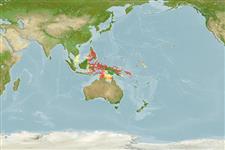Classification / Names
Common names from other countries
Main reference
Size / Weight / Age
Max length : 3.1 cm SL male/unsexed; (Ref. 87358)
Environment
Marine; demersal; depth range 7 - 70 m (Ref. 87358)
Climate / Range
Tropical, preferred ?
Distribution
Western Pacific: from Indonesia (SW Sulawesi) north to the Philippines (Palawan) and eastwards to the Solomon Is., probably also in Palau.
Countries | FAO areas | Ecosystems | Occurrences | Introductions
Short description
Dorsal
spines
(total): 7;
Dorsal
soft rays
(total): 10;
Anal
spines: 1;
Anal
soft rays: 8 - 10. This species is characterized by having the following characters: a relatively deep body, numerous irregular scales with about 30 lateral rows and over 15 scales in the anterior transverse series, a fifth pelvic fin ray that branches twice dichotomously, usually a somewhat elongate second dorsal spine, no predorsal, cheek or opercular scales, a moderately wide bony interorbital with a fleshy median ridge between the eyes, and a dermal ridge anterior to the first dorsal spine. There is a red spot or elongate blotch above the opercle in live and fresh material, and the dorsal surface of the snout has a reticulated dark pattern, with dark transverse stripes over the dorsal margin of the orbit (Ref. 87358).
IUCN Red List Status (Ref. 115185)
Threat to humans
Harmless
Human uses
More information
Common namesSynonymsMetabolismPredatorsEcotoxicologyReproductionMaturitySpawningFecundityEggsEgg development
Age/SizeGrowthLength-weightLength-lengthLength-frequenciesMorphometricsMorphologyLarvaeLarval dynamicsRecruitmentAbundance
ReferencesAquacultureAquaculture profileStrainsGeneticsAllele frequenciesHeritabilityDiseasesProcessingMass conversion
Tools
Special reports
Download XML
Internet sources
Estimates of some properties based on models
Phylogenetic diversity index
PD50 = 0.5000 many relatives (e.g. carps) 0.5 - 2.0 few relatives (e.g. lungfishes)
Trophic Level
0
Resilience
High, minimum population doubling time less than 15 months ()
Vulnerability
Low vulnerability (10 of 100)
Price category
